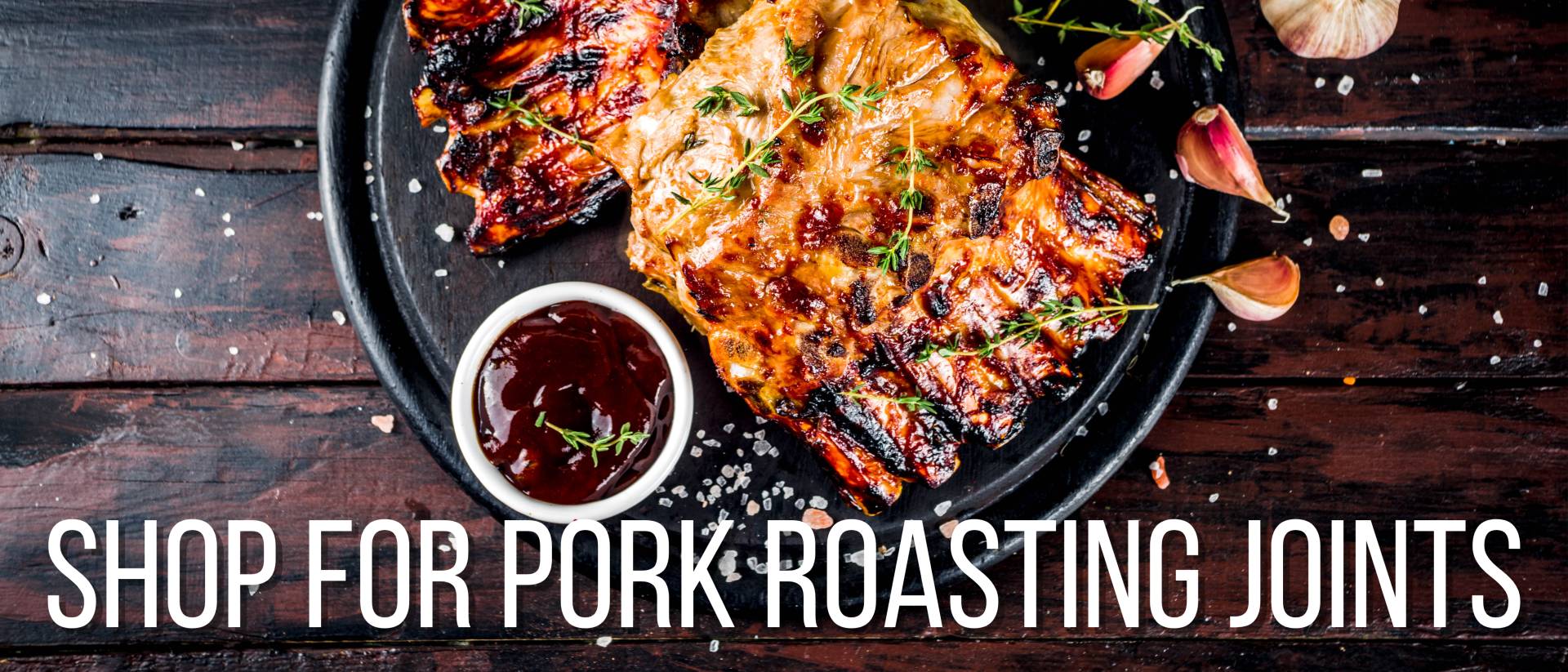
Pork Shoulder
Description: Pork shoulder is known for its rich fat content and connective tissue, making it ideal for slow-roasting. This cut is perfect for pulling and shredding due to its tender and moist texture after long cooking times.
Characteristics:
- Marbling: Good marbling contributes to its succulence and flavour.
- Fat Content: Higher fat content enhances juiciness and taste.
- Bone-In: Cooking with the bone in adds flavour and assists in maintaining moisture.
Best For:
- Roasting: Slow roasting allows the fat to render and connective tissues to break down, resulting in tender meat.
- Pulled Pork: Ideal for making pulled pork, where the meat is cooked until it can be easily shredded.
Cooking Tips:
- Score the skin to ensure crispy crackling.
- Slow roast at a low temperature to break down the connective tissue without drying out the meat.
- Allow the pork shoulder to rest before pulling or carving to retain its juices.
Serving Suggestions:
- Sauces: Apple sauce or a spicy barbecue sauce pairs well.
- Sides: Coleslaw, roasted root vegetables, or a warm potato salad complement the pork.
- Wine Pairing: A full-bodied white wine like Chardonnay or a light red wine like Pinot Noir enhances the pork's flavours.
More Detailed Cooking Tips
Pork Leg
Description: The pork leg is a leaner cut compared to the shoulder, offering a more refined flavour. It's well-suited for roasting and slicing, making it a popular choice for celebrations and Sunday roasts.
Characteristics:
- Marbling: Moderate marbling provides a balance of flavour and tenderness.
- Fat Content: Less fat compared to the shoulder but enough to keep the meat moist.
- Bone-In or Boneless: Available both ways, bone-in can enhance flavour and juiciness.
Best For:
- Roasting: Ideal for a traditional roast pork, where the meat is cooked to perfection with a golden and crispy skin.
- Carving: The structure of the leg makes it excellent for slicing into neat portions.
Cooking Tips:
- Score the skin for optimal crackling.
- Use a meat thermometer to avoid overcooking, ensuring the meat remains moist and tender.
- Rest the meat before slicing to allow the juices to redistribute.
Serving Suggestions:
- Sauces: A classic gravy or mustard sauce complements the leg.
- Sides: Mashed potatoes, steamed greens, or a bean salad.
- Wine Pairing: Riesling or a light-bodied red wine like Grenache.
More Detailed Cooking Tips
Belly Pork
Description: Belly pork is celebrated for its rich flavour and succulence, attributed to the layers of meat and fat. It's a versatile cut that offers a delectable texture contrast when cooked properly.
Characteristics:
- Marbling: Excellent marbling, contributing to its taste and texture.
- Fat Content: High fat content, which renders down during cooking to create a tender and flavourful dish.
- Bone-In or Boneless: Typically offered boneless for even cooking and easy slicing.
Best For:
- Roasting: Slow roasting allows the fat to render while the meat remains tender and juicy.
- Crispy Skin: The skin crisps up beautifully, offering a contrast to the tender meat.
Cooking Tips:
- Score the skin deeply to enhance the crackling.
- Start with a high temperature to crisp the skin, then slow roast to tenderise the meat.
- Press the belly overnight before cooking to help the fat render and keep the meat flat and even.
Serving Suggestions:
- Sauces: A tangy apple cider vinegar sauce or a rich red wine reduction.
- Sides: Braised red cabbage, roasted parsnips, or a crisp apple salad.
- Wine Pairing: A robust Zinfandel or a crisp Sauvignon Blanc.
More Detailed Cooking Tips
Collar Joint
Description: The collar joint, from the neck of the pig, is a marbled cut that's known for its flavour and tenderness. It's a traditional cut that's gaining popularity for roasting and braising.
Characteristics:
- Marbling: Excellent marbling that ensures a moist and flavourful roast.
- Fat Content: Moderate to high fat content, contributing to its rich taste.
Best For:
- Roasting: Slow cooking brings out its natural tenderness and flavour.
- Braising: Also suitable for braising in a liquid to infuse additional flavours.
Cooking Tips:
- Marinate overnight to enhance its natural flavours.
- Roast slowly to allow the fat to render and the meat to become tender and juicy.
- Rest before serving to allow the juices to redistribute throughout the meat.
Serving Suggestions:
- Sauces: A spicy mustard sauce or a classic pork gravy.
- Sides: Scalloped potatoes, buttered carrots, or a green bean almondine.
- Wine Pairing: A medium-bodied Merlot or a rich, oaky Chardonnay.
More Detailed Cooking Tips
Pork Loin
Description: Pork loin is a prime cut, lean and tender, with a delicate flavour. It's excellent for roasting whole and produces elegant slices that are perfect for more formal dining occasions.
Characteristics:
- Marbling: Moderate marbling ensures tenderness.
- Fat Content: Less fat than other cuts, but with a layer of fat on top to keep it moist during cooking.
- Bone-In or Boneless: Available both ways, with bone-in providing more flavour and moisture.
Best For:
- Roasting: Ideal for a classic roast, producing a tender, moist, and flavourful meat.
- Slicing: The structure allows for easy slicing into beautiful, even portions.
Cooking Tips:
- Tie the loin with butcher's twine to help it keep its shape during cooking.
- Sear the outside before roasting to lock in flavours and juices.
- Use a meat thermometer to avoid overcooking, ensuring the loin remains juicy.
Serving Suggestions:
- Sauces: A light herb sauce or an apple compote.
- Sides: Herb-roasted new potatoes, steamed asparagus, or a quinoa salad.
- Wine Pairing: A light Pinot Noir or a crisp, dry Riesling.
Each of these pork roasting joints offers unique characteristics and flavours, making them suitable for a variety of dishes and occasions.
More Detailed Cooking Tips
